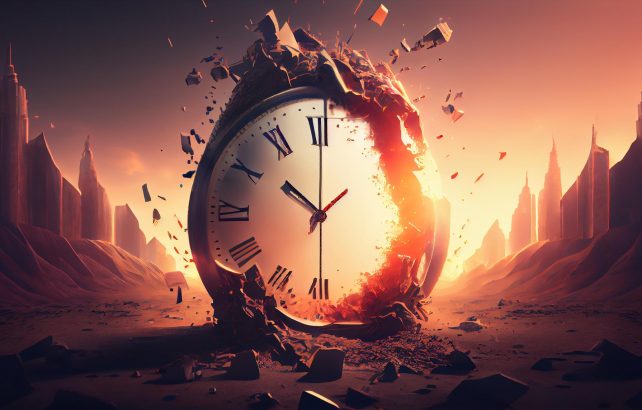The Doomsday Clock: What Makes It Move Closer to Midnight?
 The time displayed by the Doomsday Clock symbolises the decline of civilisation: the closer to midnight, the closer to the self-destruction of humankind. This symbolic figure is designed to give society a clear message about the grave and ever-growing existential threat posed to the world by nuclear weapons, the climate crisis, and future technologies being developed.
The time displayed by the Doomsday Clock symbolises the decline of civilisation: the closer to midnight, the closer to the self-destruction of humankind. This symbolic figure is designed to give society a clear message about the grave and ever-growing existential threat posed to the world by nuclear weapons, the climate crisis, and future technologies being developed.
In an episode of the Vilnius University (VU) podcast “Mokslas be pamokslų” (“Science without Sermons”), Professor Margarita Šešelgytė, political scientist and the director of the Institute of International Relations and Political Science at Vilnius University, discusses the idea of the Clock and its significance.
What is the Doomsday Clock?
According to Prof. M. Šešelgytė, the idea of the Doomsday Clock was ignited by events that shook the world: “I would describe the Doomsday Clock as an advertising product whose aim is to draw the attention of humankind to the fact that certain progress, technologies, the development of weapons, or our way of life may lead us to self-destruction. This Clock was invented in 1947 by researchers from the University of Chicago under the name of the Atomic Scientists. Taking into account the historical context of that time – nuclear bombs had been dropped on two cities in Japan just a few years before – it was already clear that awful weapons with dire consequences for humankind had been created. The arms race had begun; this caused huge concern that possession of such technologies would lead to self-destruction. The Clock was designed to measure the period until midnight, representing how much time was left for humankind before self-destruction”.
According to the Professor, the Doomsday Clock deemed the Cuban Missile Crisis to be the most dangerous time in the 20th century, displayed as two minutes to midnight. The global security situation was viewed the most optimistically when the Clock displayed seventeen minutes to midnight.
Prof. M. Šešelgytė claims that this Doomsday Clock needs to be alarming to draw people’s attention to the changes happening in the world: “Seventeen minutes was the farthest from midnight; since then, the time has only drawn closer to midnight. For several years now, the time has been counted in seconds – in 2023, the Clock’s setting was nearest to midnight with only 90 seconds left”. The professor at Vilnius University thinks that the war in Ukraine also affected this, as the Doomsday Clock is mainly associated with weapons, especially nuclear ones. Moreover, as time passes, other factors, such as climate change and the impact of technologies on security, have also been recognised as threats.
Scientists set the time on the Doomsday Clock annually and make a statement with their rationale on how and why they measured it in such a way. Last year’s statement focused on the war in Ukraine and nuclear issues. Climate change and technologies were taken into account as well. “This summer brought many natural disasters, such as fires, floods, and hurricanes. Scientists are concerned about this, as well as technologies, artificial intelligence, and cyber security. The list of those involved in making decisions on the setting of time of the Doomsday Clock include people working in different fields: civil servants, security experts, specialists in nuclear physics, cyber security, climate change, and public healthcare”, explains Prof. M. Šešelgytė.
Is the Doomsday Clock effective?
According to the Professor, even though the idea of the Doomsday Clock is not that widely known, it works well for raising awareness: “When I tell my students about this Clock, usually only a few of them have heard about it before. People have a tendency to respond to threats that are familiar to them and that they understand. For example, we have a peaceful life here in Lithuania: the weather is not too hot, and we do not suffer from floods or fires. It seems to us that climate change is practically non-existent, and, as a result, it is more difficult to convince people to take immediate action regarding this issue. The war in Ukraine is familiar to us, and we understand it as a threat. However, people in the West find this threat harder to understand. Thus, I would say that the Doomsday Clock is a rather effective means for drawing people’s attention as many refer to it when the security situation is discussed”.
Will the Doomsday Clock show midnight?
Prof. M. Šešelgytė emphasises that both large and small countries can influence the international political situation: ‘In fact, we see erosion in international organisations and international law, and this ongoing conflict is very important. This is a litmus test for countries dissatisfied with the existing international order and wishing to change it. Countries like China or Iran probably think the world should be managed differently. Breaches of international agreements do not bode well. If we allow the principles that were considered sacred in international relations to be broken – e.g. the principle of sovereignty, according to which a country does not have a right to attack another country and occupy it – we will witness the collapse of the international order. The solutions are in the hands of the powerful as well as the small countries, which must make an effort not only to help Ukraine but also to fight for the remaining functioning international institutions or the reform of underperforming ones. The world is divided at the moment; the trust of some African countries in the West has significantly declined. Much effort is required to convince them that the West does not intend to harm them and that they should not count on their friendships with China and Russia. Luckily, understanding is growing that China – the new colonialist state – and Russia’s Wagner are not their best allies.

According to the Professor, it is very important to note not only the tense political situation in the world but also other factors getting the Doomsday Clock closer to midnight: “The scientists working on the Doomsday Clock state that the global temperature will increase by two degrees by 2050, which is already a disaster, as the goal was to retain the temperature at approximately 1.5 degrees to avoid irreversible changes that may have catastrophic consequences. We are rapidly approaching that number, as this summer’s events show. Countries adopt very different approaches depending on whether they are rich or poor, polluting or clean. Thus, finding a common consensus is difficult as the risks and threats of climate change are different. The implementation of agreements usually fails, but there is slight progress. For example, India is one of the largest polluters, and it is very difficult to redirect the economy of such a large and poor country to make it ecological. However, some interesting processes have been noticed: bicycle transport is very popular there, and it is being rapidly electrified. There is a large shift towards electric means of transport, and this has already had an impact. So, even though we are moving slowly, it is still progress in the right direction”.
Prof. M. Šešelgytė believes that it is hard to expect a more positive movement of the Doomsday Clock: “It will be impossible to expect an optimistic approach in the next ten to twenty years due to a growing number of threats associated with unknown technologies, climate change, and conflict in our society. It was probably easier with just a single main threat when the Clock was created: there were two blocs, one of which had collapsed, which was why optimism spread. Today, we are witnessing processes that are completely the reverse. I would like to believe, however, that the Clock will not hit midnight”.